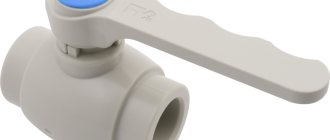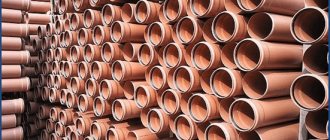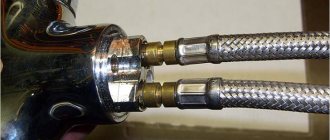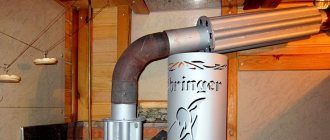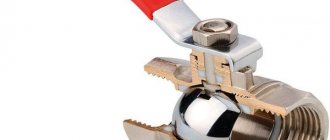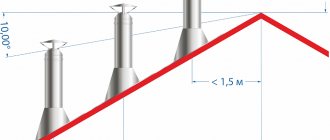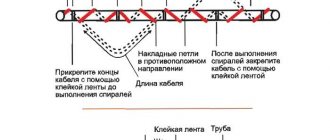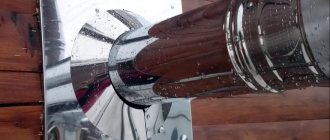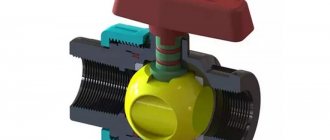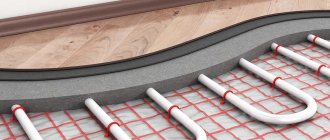A coupling is a cylindrical device for connecting drive shafts or pipelines. The main purpose is to transmit torque without changing its module and direction, or to connect pipe fragments into one.
Couplings for plastic pipes are used very often during pipeline installation. This seemingly simple part is actually an important element of the plastic pipeline.
Plastic, which has almost replaced metal and cast iron products, has proven itself to be the best option for laying networks for any purpose.
But, during installation work, it becomes necessary to connect pipeline sections into a single network. And couplings come to our aid.
What are they and why is it needed?
There are several types of polyvinyl chloride couplings for pipe assembly, used depending on the type of connection.
Assembly methods and couplings used:
- socket connection - used for non-pressure water supply and external sewage systems; couplings are sometimes used to connect the system to old cast iron systems. The parts are connected like in a children's construction set;
- adhesive connection, or “cold welding”. Couplings of a simple shape, similar to a piece of tube, with an internal diameter equal to the outer diameter of the pipes being connected, and special glue are used. There are straight shapes, angular ones, tees, transitional from one diameter to another;
- butt connectors for connecting to other types of pipes. Most often, there are products with a pipe with an external thread, sometimes with an internal thread, and they also come with a coupling connection. The second pipe is connected to the system using glue;
- dismountable pipe couplings in different versions - on one side there is a solder pipe, on the other - with a thread.
Purpose of PVC couplings
To connect pipes with each other and with different devices, there are couplings - parts that are used as connecting or protective elements when installing systems made of hollow pipes.
A system consisting of pipes always has several weak points - the place where the system begins, its end and the connections between the pipes. For example, if we are talking about heating, then the weak points will be the transition of the heating device into the pipe, the pipes into the radiator, and all the points where the pipes connect to each other. It is in these places that accidents most often occur and the system leaks.
In order to eliminate the possibility of depressurization, it is necessary to ensure a strong connection. Nobody connects plastic pipes end to end with each other. Even if you install sealant or a rubberized ring, such a connection will not be reliable enough.
In addition to connecting, couplings provide pipe protection. They are placed over the pipe, protecting the joint from adverse external factors.
Purpose and scope
Any couplings are designed for connecting PVC pipes to each other or connecting a PVC system with pipelines or fittings made of other materials (steel, polyethylene, polypropylene).
The scope of application of plastic pipes and bushings is absolutely everywhere where there are pipeline systems: in residential buildings, in production, in agriculture, in urban networks, oil and gas pipelines, and the mining industry.
The great advantage of propylene polyvinyl chloride is the fact that it does not burn - in recent years, even fire-resistant water pipes have begun to be made from PVC pipes.
Types of coupling connections
Couplings intended for plastic pipes are of types that differ in structural features, technical characteristics and installation method. In addition to couplings, there are other types of fitting parts that are installed on plastic systems.
For example, heat-resistant or cast connecting devices can be used for a gas main, and corrugated types of these products can be installed on a sewer pipeline.
COUPLING. PURPOSE
A coupling installed on a polyethylene (PE) pipeline is one of the parts that provide a reliable and tight connection with the rest of the fittings. According to their intended purpose, these products are classified into:
- connecting (repair). This type of parts is intended for hermetic and reliable joining of highway elements, and for eliminating emergency situations.
- Protective. It is already clear from the name itself that these shaped elements are used to protect polyethylene materials from damage.
Advantages and disadvantages
Products made from polyvinyl chloride have many advantages:
- simple design;
- tightness;
- durability;
- reliable strong connection;
- small hydraulic resistance equal to the resistance of the pipe;
- easy installation;
- corrosion resistance;
- resistance to ultraviolet radiation;
- frost resistance;
- a certain plasticity.
Flaws:
- polyvinyl chloride “leads” at elevated temperatures; products made from it are operated at a maximum temperature of 66°C;
- pressure is limited to 1.6 MPa.
Why is it necessary to connect plastic pipes without soldering?
The cost of a special soldering iron is several thousand rubles, so purchasing it for one-time installation on your own is impractical. Even experienced craftsmen use alternative methods in cases of:
- when you need to connect only 2 - 3 joints;
- when replacing a damaged pipeline section;
- for laying plastic pipelines with low hydraulic load, for example, sewage;
- to create detachable connections if there is a need for regular disassembly of the pipeline for preventive maintenance;
- when installing temporary pipelines.
Types and differences
Types of couplings:
- for adhesive joints (straight, corner, tees, reducing when connecting pipes of different diameters);
- bell-shaped;
- transitional between pipelines made of different materials (polypropylene, polyethylene, metal) or PVC and brass or steel fittings, HDPE fittings (with pipes, pipes with American union nuts or flanges). A characteristic feature of such fittings is the presence of metal threaded pipes or flanges;
- dismountable products;
- thermistor models for electric welded pipe assembly;
- stubs.
It is also worth mentioning PVC ball valves, structurally made on the basis of a collapsible coupling (see photo)
Installation Tips
Installation of sewer systems is not structurally difficult, the main thing is not to forget that there is a gasket in the socket, and even coat the gasket with silicone.
When laying home cold water supply systems, “cold welding” is most often used.
Required tools and materials
You will need a grinder with cutting discs, glue, a file, rags, alcohol (denatured alcohol can be used), a coupling, and pipes.
Welding technology
“Cold welding” of pressure water supply systems is performed using a special PVC glue. The technology is quite banal: lubricate the surfaces to be joined, connect, hold.
Work order
When connecting pipelines using bushings, there are some peculiarities; below is the step-by-step sequence of work:
- The ends of the pipes to be connected are cut exactly perpendicularly and cleared of burrs with a file. Clean from dust and shavings using a rag. It is advisable to remove small chamfers;
- insert the pipes into the coupling until it stops, mark with a mark the depth to which the pipe is inserted into the fitting;
- disassemble the assembly, degrease the pipes and fittings;
- Using a clean brush, apply special glue to one pipe from the outside and the corresponding inner surface of the fitting. The glue should be applied quickly and immediately, before the glue dries, insert the pipe into the coupling and hold it in this state for 20-30 seconds. Then the joint should be left for 10 minutes (if the air temperature is at least 10°C) until it sets firmly. From the moment you start applying the glue until the knot is fixed, no more than 20-25 seconds should pass, otherwise the glue will begin to harden and the quality of welding will deteriorate;
- then coat the second side of the fitting and the second pipe, connect, hold;
- it is necessary to control the depth of penetration of the pipe into the fitting - it must be inserted into the coupling to the mark made;
- if the connection is made correctly, a thin strip of escaping glue will appear at the joint - it must be wiped off with a rag;
- It is advisable to secure the mounted section in the fastenings and leave it for a day;
- It is necessary to ensure that the glue does not have time to dry on the surfaces to be joined. Dried glue glues surfaces less reliably;
- The system can be filled with water and tested no earlier than 24 hours after welding.
Our video shows the process of welding pipes in all its details:
Features of the use of thermistor electric welded couplings
In order to provide various options for joining pipe products, the following coupling devices were provided:
- Electric, they are also thermistor.
- Compression and crimp.
Thermistor shaped parts have a built-in heating element, which makes it possible to obtain a permanent connection.
The most reliable method of joining pipeline elements is the welding method. To accomplish this, electric couplings are used. A special feature of thermistor devices is their installation. It can only be done using special welding equipment. The connection is made using copper wire.
It heats up under the influence of electricity and brings the polyethylene into a molten state, which then leads to the formation of a very reliable joint.
To use such a fitting part, you need the following.
- Prepare pipe assortment for welding work. At the same time, the plastic pipes are thoroughly cleaned from dirt and dust. Also, in the area of the planned joint, carefully remove the thin surface layer of polyethylene.
- The material prepared for work is placed on one axial straight line. This applies to parts of the line and the electric coupling.
- Electricity is connected to the coupling.
- The built-in heating element begins to warm the part to the desired temperature level. In this way, melting of the end surfaces that are in contact is ensured.
- When heated, polyethylene products expand and fit tightly against each other.
- Next, the current supply is turned off, and the completed structure must stand still until it cools completely.
- After twenty minutes, a tight and durable joint emerges.
Electrofusion couplings of modern production are advantageous in that they can independently control the entire process of welding and subsequent cooling. Installation of such parts is advisable in limited space.
The use of this connection option is called priority when the butt option is inconvenient and impractical. Such places, as a rule, are wells, channels with poor access, installation holes in the foundation or wall of a building.
Another advantage is that it is appropriate to use in emergency situations when a plastic or polypropylene pipeline is damaged. And, when the defect must be eliminated in a very short time.
Installation of electric welded couplings
In addition, this device is easy to install, and any home craftsman without great skills can do the job.
The only drawback in this case is the high price of the device, which is understandable, not everyone can afford. The cost of these products is much higher when compared with analogues, but this is more than compensated for by the speed of installation and the reliability of the resulting connection.
Protective coupling parts
It has already been described that protective fittings for a plastic system are designed to protect the pipe structure from mechanical damage. These are solid fittings into which the pipe is mounted. As a result of such actions, the pipe assembly does not come into contact with reinforced concrete, and its integrity remains unchanged.
These products are used for installation in a reinforced concrete wall of a sewer well. They protect input and output structures, compensate for the load on the plastic line and maintain a high level of joint tightness.
The device, which is installed in the wall, is fixed with a cement mortar, and creates a hole of the required size for laying the pipeline.
The main purposes of these fittings.
- Reducing the force of external influence generated after vibration and changes in diameter due to temperature changes, as well as after “settling” of the walls.
- Design of the landing area with a smooth surface inside.
- Partial leveling of the influence on the pipeline from the inside.
An additional compensatory function here is performed by sealing rings.
Professional plumbers from this line of products highlight the quality of devices made of three-layer PVC with a foam wall inside. Although, analogues made of PVC also have high technical characteristics.
Protective case
The hardness class of these products is SN4. And they can be used for a very long time. Subject to operating conditions, such devices last longer than 50 years.
Protective cast coupling devices HDPE are special devices for protection. They are distinguished by a special design, where the outer part can slip, and is equipped with special stiffening ribs.
They are notches that allow the cast device to be firmly anchored in the wall. Inside such a product there is a sealing ring that allows the fitting to fit tightly to the pipe and protects the part inside the connecting device from clogging with earth.
Protective connecting mechanisms are one-piece products, which allows them to easily cope with the functions assigned to them.
The diameters of these devices can be found from 110 to 1200 mm. This volume absolutely coincides with the volume of PE pipelines. The length of the options offered for sale varies from 150 to 510 mm.
If for work you need to purchase a coupling part of other diameters, then it can be obtained by special order. Almost all companies can supply couplings with non-standard dimensions.
The use of protective devices is called the most competent solution, since during operation any plastic line is subject to movement and deformation changes.
THREADED COUPLING. PURPOSE
As a result, the concrete well begins to collapse. As a consequence of this, the pipe structure is also destroyed. But, if there are protective types of couplings on it, then all such vibrations are completely leveled out, because they take place in the coupling device itself.
Compression devices
This type of connecting elements for installation, unlike electric welding devices, does not require the use of special equipment. Welding is not necessary in this situation.
Using compression parts, you can create a detachable connection that can be disassembled if necessary. Such joints can be disassembled and reassembled as many times as necessary.
Compression devices are divided into:
- devices that fasten tubular products that have the same diameter;
- adapters for connecting highways of various volumes;
- products with external thread;
- devices that have an internal thread.
The connecting products of this line are made from environmentally friendly materials. This type of fitting devices does not create any difficulties during installation. To build a reliable joint you need:
- prepare the coupling device; to do this, it is partially disassembled and the union nut is unscrewed 3/4 turns;
- prepare the pipe, while its surface part is cleaned of contamination with a chamfer remover or a well-sharpened knife;
- the size of the coupling part entering the body is marked on the pipe;
- to facilitate installation, it is recommended to wet the compression mechanism with liquid soap or apply special lubricant to it;
- the pipe is inserted into the coupling device until the specified mark; during these actions it is necessary to apply a certain force;
- then the union nut is tightened until it stops;
- In order for the created connecting fastener to be airtight, it is necessary that the threads be protected with foam tape.
Flange connection elements
These connecting devices are capable of ensuring high tightness of the joint created on the structure, and professional craftsmen claim that this coupling mechanism is characterized by fairly simple installation. The seal on flange couplings is made of special paronite gaskets.
This connecting device also includes a metal flange and a polyethylene tube.
The price for this line of connecting products is affordable, which can also be added to its undeniable advantages.
